AI Research
50 NEW Artificial Intelligence Statistics (June 2025)
This is a list of up-to-date artificial intelligence stats for 2025.
From ChatGPT to autonomous vehicles, AI is one of the most exciting (and controversial) technology trends in the 21st century.
But how big is the AI space? And how quickly is it growing?
In this article, we’ll take a closer look at key AI statistics, along with growth projections for the future.
Want to Beat Your Competition?
Find out who’s linking to them and build a better backlink strategy.
Top AI Statistics (Editor’s Picks)
- The global AI market is valued at approximately $391 billion.
- The AI industry is projected to increase in value by around 5x over the next 5 years.
- The AI market is expanding at a CAGR of 35.9%.
- As of 2025, as many as 97 million people will work in the AI space.
- 83% of companies claim that AI is a top priority in their business plans.
- Netflix makes $1 billion annually from automated personalized recommendations.
- 48% of businesses use some form of AI to utilize big data effectively.
- 38% of medical providers use computers as part of their diagnosis.
Artificial Intelligence Market Size
The AI market is worth around $391 billion (GrandViewResearch)
As of the latest available data, the global AI market is worth almost $400 billion.
This is primarily thanks to increasing practical use cases of AI technology, from content creation to self-driving cars.
Want to Spy on Your Competition?
Explore competitors’ website traffic stats, discover growth points, and expand your market share.
The global AI market is expected to reach $1.81 trillion by 2030 (GrandViewResearch)
While the current AI market is sizeable, it’s set to grow by nearly 5x over the next few years.

During this forecast period, the AI market is predicted to increase by a CAGR of 35.9%.
The AI software market’s global annual revenue stands at over $100 billion (Omdia)

The AI software market’s global annual revenue (2018 to 2025):
| Year |
Revenue |
| 2018 |
$10.1 billion |
| 2019* |
$14.69 billion |
| 2020* |
$22.59 billion |
| 2021* |
$34.87 billion |
| 2022* |
$51.27 billion |
| 2023* |
$70.94 billion |
| 2024* |
$94.41 billion |
| 2025* |
$126 billion |
*Projected figures.
ChatGPT reached 1 million users in 5 days (OpenAI)
In late 2022, ChatGPT broke records as the AI platform reached 1 million users in less than a week.
By early 2023, ChatGPT had accumulated over 100 million monthly users.
And as of May 2025, OpenAI.com receives 1.2 billion monthly visits. ChatGPT.com receives over 5 billion visits, making it the #5 website globally.
Website visitors from AI search are 4.4x more valuable than visitors from organic search (Semrush)
And traffic from ChatGPT search is projected to overtake traffic from organic search in 2028.
To adjust to these emerging changes in search behavior, brands are moving to platforms such as Semrush Enterprise AIO to improve their visibility in AI search engines.

9 out of 10 organizations back AI to give them a competitive edge over rivals (MIT Sloan Management)
One survey found that 87% of global organizations believe that AI technologies will give them a competitive edge.
This equates to an increase of 12% from the previous year.
AI Adoption: Artificial Intelligence Growth
Between 2015 and 2019, the number of businesses utilizing AI services grew by 270% (Gartner, Forbes)
In 2015, just 10% of organizations used or planned to implement AI in the near future.
By 2019, this figure had surged to 37%.
Meanwhile, in the UK, the number of AI companies has increased by 600% over the past decade.
Approximately 1 in 3 organizations use AI (Hostinger)
According to Hostinger Tutorials, 35% of companies have turned to AI services to address labor shortages.
And 42% are considering AI adoption in the near future.
Global AI is growing at a CAGR of almost 40% (Grand View Research)
AI’s recent rapid growth is unlikely to slow down in the near future.
In fact, global AI adoption by organizations is set to expand at a CAGR of 35.9% between 2025 and 2030.
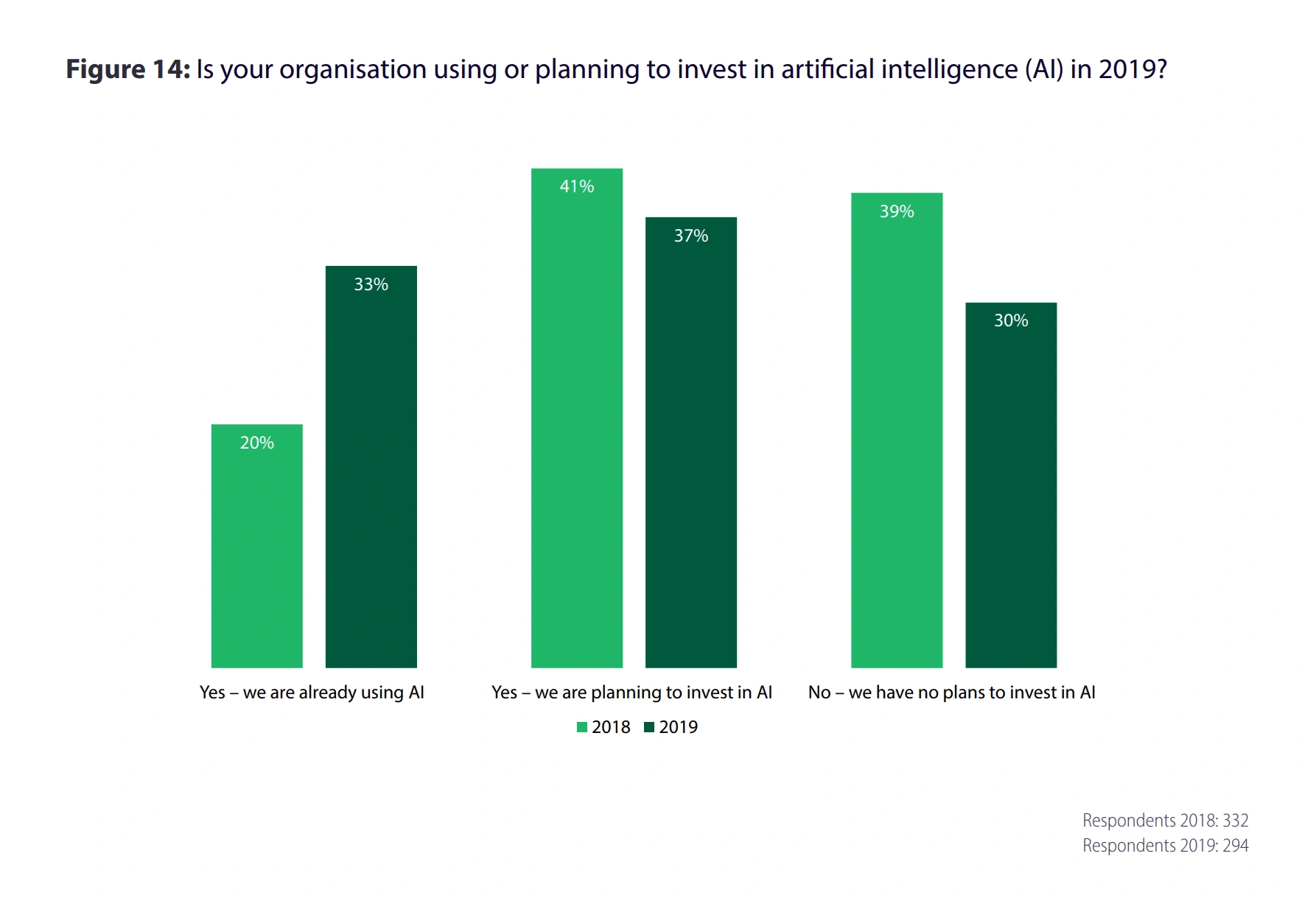
The wearable AI market is expected to reach $180 billion this year (Global Market Insights)
The success of products like the Apple Watch and Fitbits is set to boost the global wearable AI market value.
As of 2025, the market is set to reach $180 billion.
Instantly Analyze
Any Market
AI tech can increase revenue by over $15 trillion by the end of the decade (PwC)
Some estimates suggest that AI technology could generate $15.7 trillion in revenue by 2030. Boosting the GDP of local economies by an additional 26%.
The AI market is set to grow by 26% this year (Tractica)
The latest available data predicts a lucrative near future for the AI market.
Between 2021 and 2022, the AI market was projected to grow by 47%.
This upward trajectory was forecast to continue year-over-year, increasing by at least 26% each year:
| Year |
Year-Over-Year Growth |
| 2019 |
54% |
| 2020 |
54% |
| 2021 |
54% |
| 2022 |
47% |
| 2023 |
38% |
| 2024 |
33% |
| 2025 |
26% |
Worldwide AI chip revenue will surpass $80 billion in the next couple of years (The Insight Partners)
The latest data shows that global AI chip revenue is set to reach $83.25 billion by 2027.
Almost 100 million people are working in the AI space (Search Logistics)
If the projections about growth in the AI space come to fruition, further manpower will be required.
By the end of 2025, approximately 97 million people will be needed to fill the work demands of the surging industry.
Business analysts estimate that the US AI market is worth approximately $75 billion (Statista)
As dependency on human intelligence decreases, this figure is set to rise further.
As of 2025, the US AI space is worth a reported $73.98 billion. That’s a predicted CAGR of 26.95% between 2025 and 2031.
How Businesses Adopt Artificial Intelligence
Around 4 in 5 companies deem AI to be a top priority in their business strategy (Forbes)
A whopping 83% of companies claim that using AI in their business strategies is a top priority.
Automated emails and chatbots are two of the most common uses of AI in everyday business communications.

Here’s a look at current company usage of AI:
| AI Usage | Percentage |
| Don’t use AI currently, but are looking into it | 7% |
| Have tested a few proofs of concept with limited success | 14% |
| We have a few promising proofs of concept and are looking to scale | 21% |
| We have processes that are fully enabled by AI with widespread adoption | 25% |
| We have started implementing limited AI use cases. | 33% |
80% of retail executives expect their businesses to adopt AI automation by the end of 2025 (Analytics Insight)
The vast majority of surveyed retail executives in 2021 believed their company would utilize AI automation by next year.
Around 17 in 20 CEOs claimed AI would be “mainstream technology” in their company in 2021 (PWC)
86% of CEOs agree that AI and business go hand-in-hand since AI is mainstream technology in their offices.
AI is expected to improve employee productivity by 40% (PWC)
Data suggests that AI has the potential to boost employee productivity by approximately 40% by 2035.

Netflix’s recommendations technology is worth $1 billion in revenue annually (Business Insider)
Many consumers will likely agree that Netflix’s use of AI is one of its biggest selling points. The streaming platform utilizes AI to personalize recommendations and tailor them to viewers’ interests.
Tech companies that invest in AI often significantly increase their revenue, as algorithms can keep the consumer constantly returning for more.
Data shows that the top voice assistant by accuracy is Google Assistant (Loup Ventures)

Google Assistant outranks its voice assistant competitors, such as Apple’s Siri and Microsoft’s Cortana, with an accuracy record of 98% in navigation.
| Type of question | Google Assistant | Siri | Alexa |
| Local |
93% |
89% |
85% |
| Commerce |
92% |
68% |
71% |
| Navigation |
98% |
86% |
72% |
| Information |
96% |
76% |
93% |
| Command |
86% |
93% |
69% |
More than half of telecommunications organizations use chatbots (Gartner)
52% of telecommunications organizations utilize chatbots to increase their overall productivity.
Recent data indicates a substantial acceleration in the adoption of AI-powered applications (Gartner)
One key AI application in business is providing personalized product recommendations via consumer behavior forecasting and targeted advertising.
Pop-up marketing ads and chatbots are each examples of AI operations.
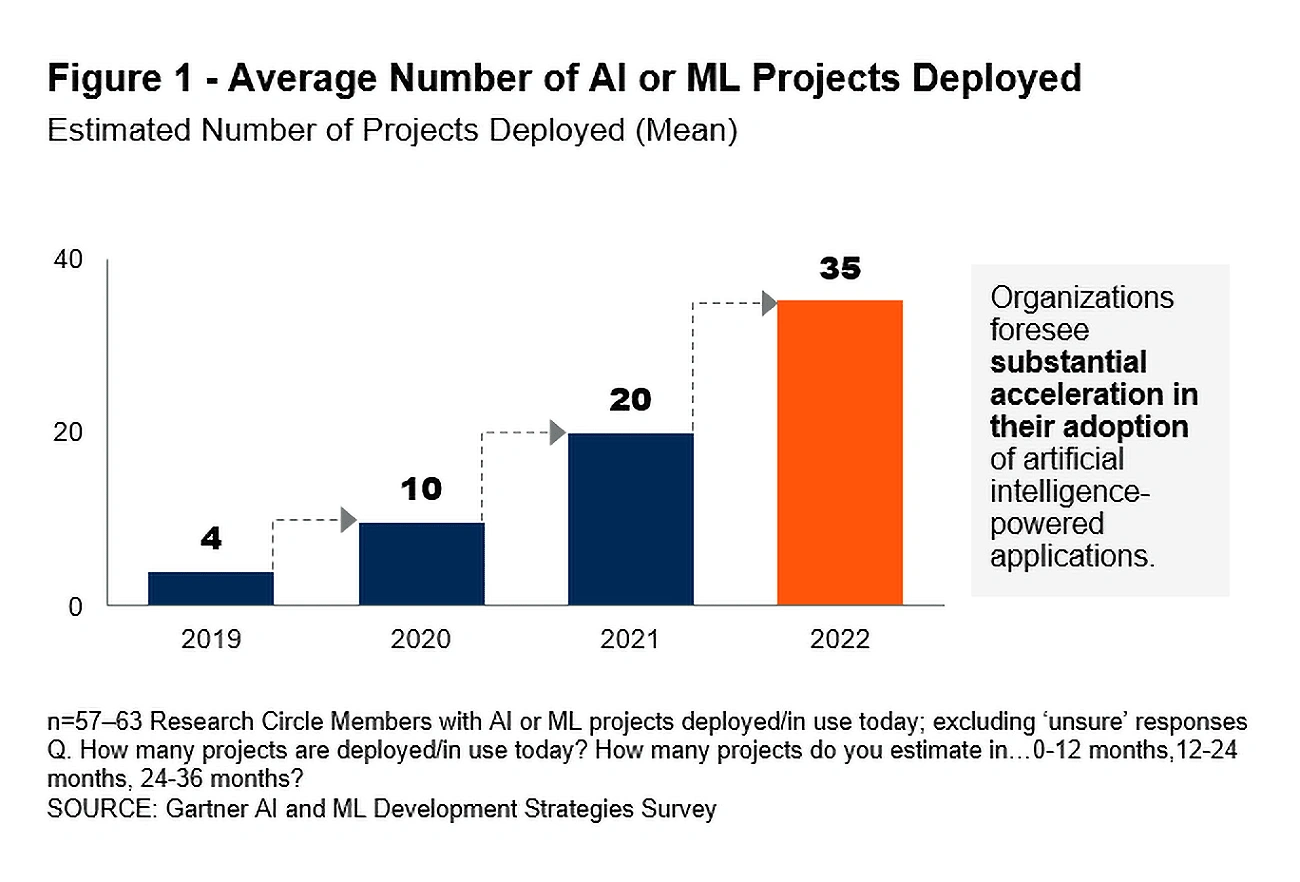
Automation usually translates to less waiting time for customers.
Nearly half of all businesses use some form of machine learning, data analysis, or AI (O’REILLY)
To maintain the accuracy of their data, 48% of businesses use machine learning (ML), data analysis, and AI tools.
The manufacturing industry stands to gain $3.78 trillion from AI by 2035 (Accenture)
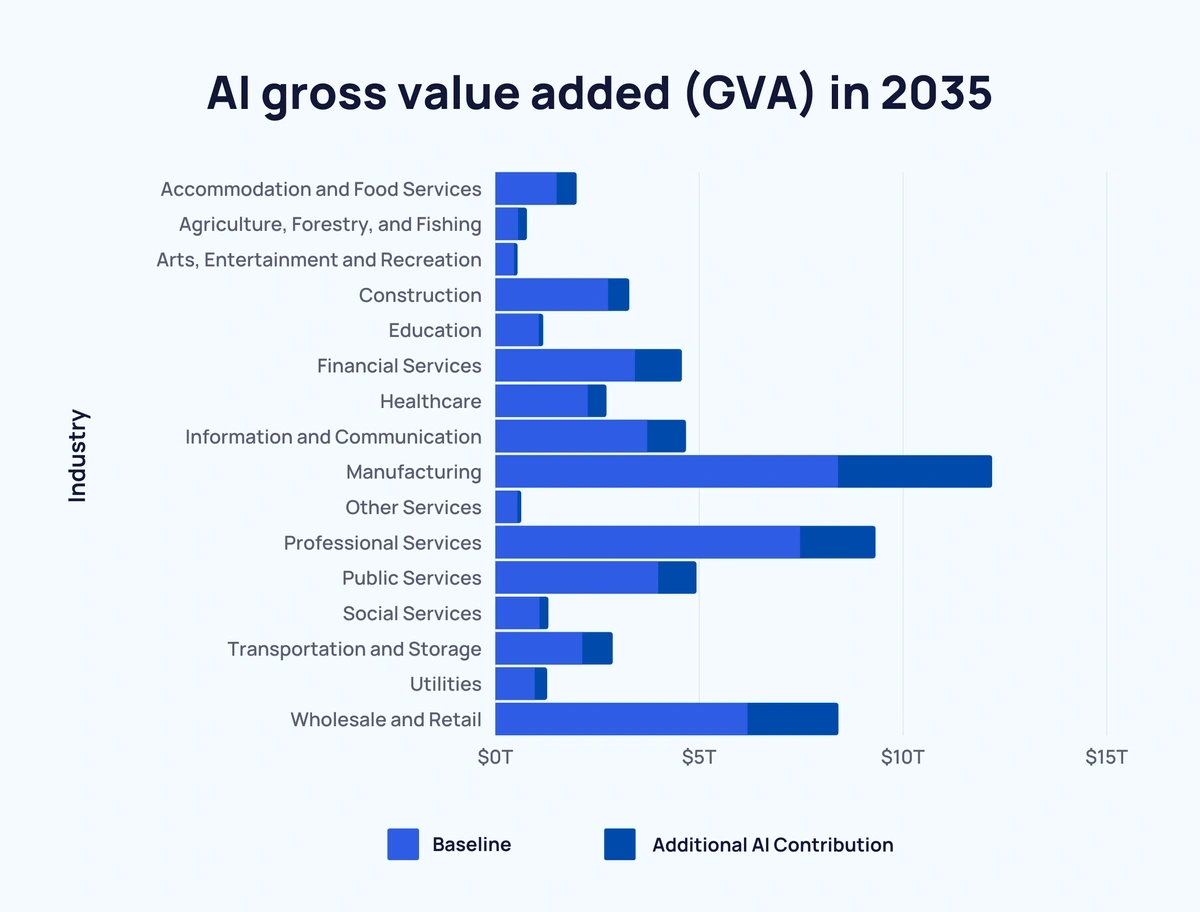
The AI industry has a foothold in various business functions, from cloud computing for datasets to streamlining company decision-making.
Industry verticals utilizing AI technology include tech-related sales, insurance, banking, telecom, healthcare, manufacturing, retail, and marketing, to name a few.
| Industry | Baseline | Additional AI Contribution |
| Accommodation and Food Services |
$1.5 trillion |
$489 billion |
| Agriculture, Forestry, and Fishing |
$554 billion |
$215 billion |
| Arts, Entertainment, and Recreation |
$453 billion |
$87 billion |
| Construction |
$2.76 trillion |
$520 billion |
| Education |
$1.06 trillion |
$109 billion |
| Financial Services |
$3.42 trillion |
$1.15 trillion |
| Healthcare |
$2.26 trillion |
$461 billion |
| Information and Communication |
$3.72 trillion |
$951 billion |
| Manufacturing |
$8.4 trillion |
$3.78 trillion |
| Other Services |
$535 billion |
$95 billion |
| Professional Services |
$7.47 trillion |
$1.85 trillion |
| Public Services |
$3.99 trillion |
$939 billion |
| Social Services |
$1.08 trillion |
$216 billion |
| Transportation and Storage |
$2.13 trillion |
$744 billion |
| Utilities |
$962 billion |
$304 billion |
| Wholesale and Retail |
$6.18 trillion |
$2.23 trillion |
Autonomous vehicles could generate between $300 billion and $400 billion in global revenue (McKinsey)
The self-driving car market is proving to be more than a novelty niche, potentially grossing $400 billion by 2035.
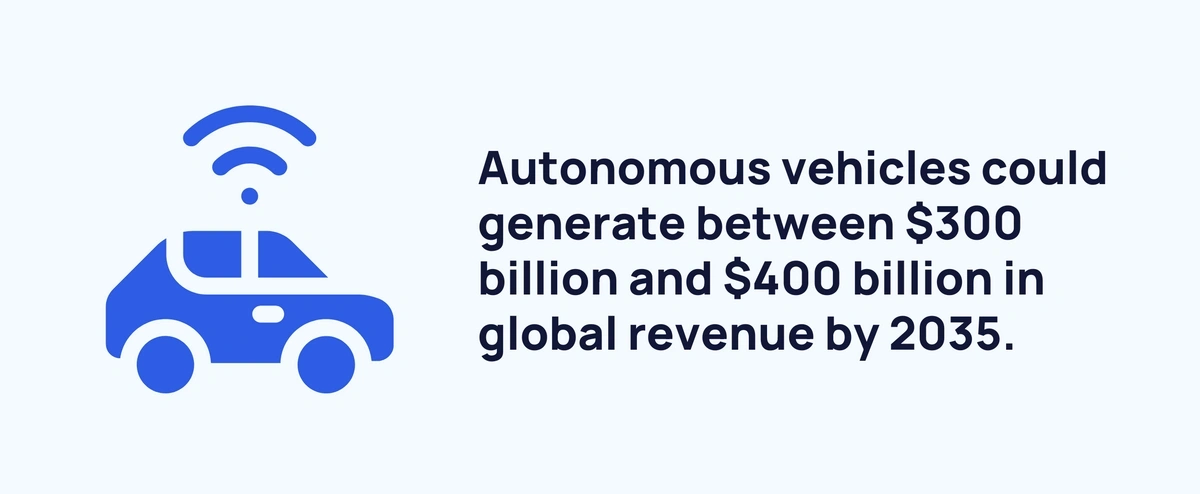
Just 7% of people trust chatbots when making a claim (Accenture)
The prevalence of chatbots may be increasing, but they still have a long way to go.
Just under 1 in 10 people (7%) trust chatbots when making a claim.
A stark difference from the 49% that trust human advisors.
AI tech is expected to increase banking industry revenue by $1 billion between 2023 and 2026 (Accenture)
By next year, AI technology will have added $1 billion to the banking industry.
Around 2 in 5 medical professionals now use computer systems to aid diagnosis (Gartner)
38% of medical providers use computer systems as their diagnosis assistants.
AI is helping manufacturing companies outperform competitors (Microsoft)
Manufacturing businesses that utilize AI are performing 12% better than businesses that continue to use traditional methods only.
19 in every 20 customer interactions will be AI-assisted as of 2025 (AI Business)
In the next few years, the retail industry will be able to relinquish much of its communication to AI.
In fact, it predicted that over 95% of online and telephone communications will utilize AI technology as of this year.
AI in Marketing, Customer Service, and Sales Statistics
Marketing and sales departments prioritize AI and ML for market revenue success 40% more than other industry departments (Forbes)
AI marketing companies, customer service roles, and sales departments rely on process automation to increase their market revenue share.
Artificial intelligence is a solution for overworked customer-facing roles.
AI algorithms increase leads by as much as 50% (Harvard Business Review)
AI algorithms reveal data on which products generate the highest profit margins and offer valuable insight into a client’s purchasing habits.
Recent data shows that using AI for sales:
- Increases leads by 50%
- Reduces call times by 60%
- Results in overall cost reductions of up to 60%
Around 4 in 10 marketers believe that AI email marketing improves market revenue (Statista)
In total, 41.29% of marketers agree that using AI for email marketing generates higher market revenue.
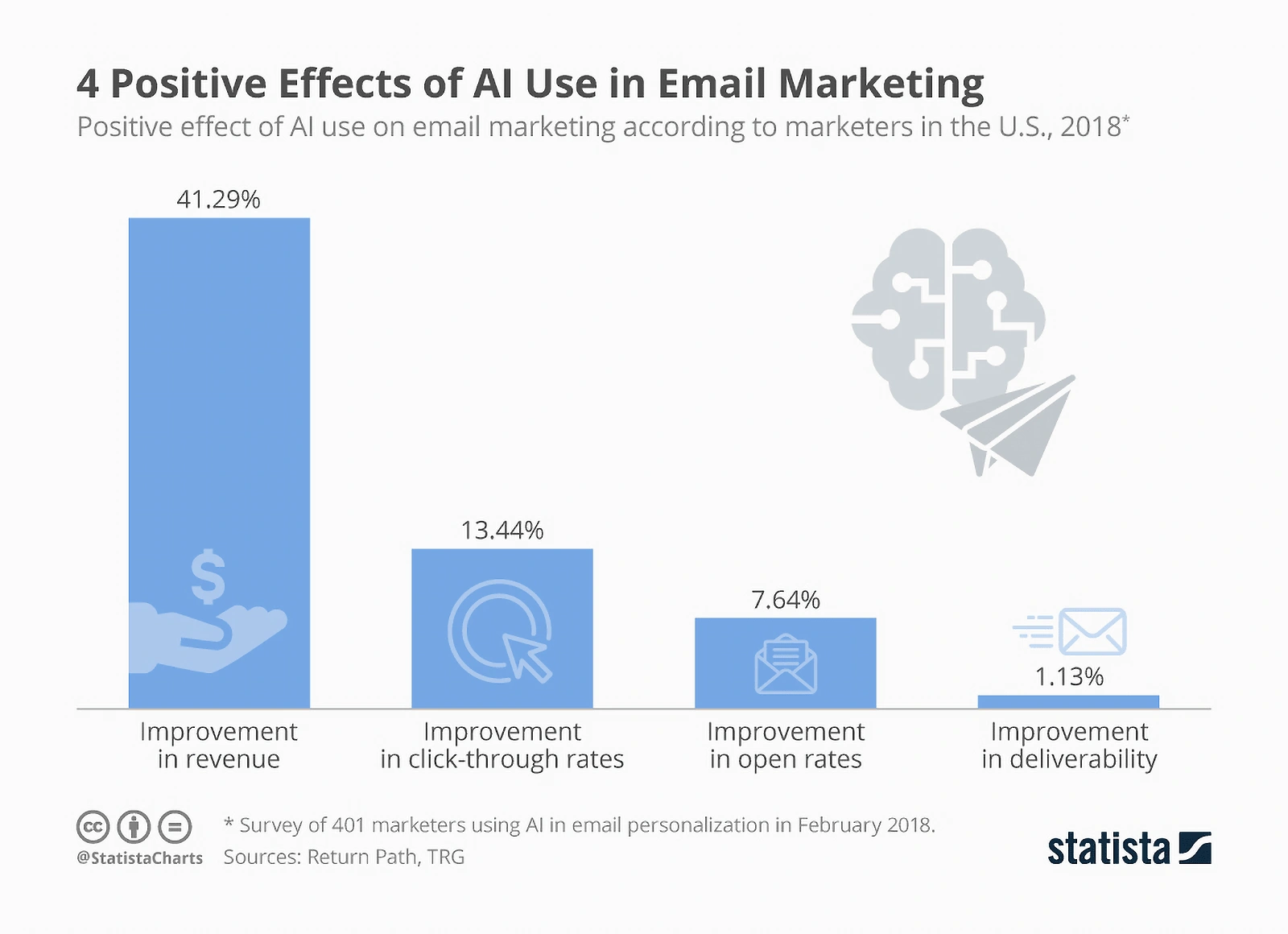
AI Replacing Jobs and Employment Statistics
Transportation and storage workers face the greatest risk of job automation (PwC)
Many people worry that AI will continue to take jobs from human workers, resulting in a job crisis.
And some are even asking whether they should start looking for a new career solution before automation makes their current role obsolete.
Want to Spy on Your Competition?
Explore competitors’ website traffic stats, discover growth points, and expand your market share.
Below is data on employment shares and the proportion of jobs at high risk of automation by the early 2030s for all UK industry sectors:
| Industry | Share of Employment | Risk of Job Automation |
| Wholesale and retail trade | 14.80% | 44% |
| Manufacturing | 7.60% | 46.4% |
| Administrative and support services | 8.40% | 37.4% |
| Transportation and storage | 4.90% | 56.4% |
| Professional, scientific, and technical | 8.80% | 25.6% |
| Human health and social work | 12.40% | 17% |
| Accommodation and food services | 6.70% | 25.5% |
| Construction | 6.40% | 23.7% |
| Public administration and defense | 4.30% | 32.1% |
| Information and communication | 4.10% | 27.3% |
| Financial and insurance | 3.20% | 32.2% |
| Education | 8.70% | 8.5% |
| Arts and entertainment | 2.90% | 22.3% |
| Other services | 2.70% | 18.6% |
| Real estate | 1.70% | 28.2% |
| Water, sewage, and waste management | 0.60% | 62.6% |
| Agriculture, forestry, and fishing | 1.10% | 18.7% |
| Electricity and gas supply | 0.40% | 31.8% |
| Mining and quarrying | 0.20% | 23.1% |
| Domestic personnel and self-subsistence | 0.30% | 8.1% |
| Total/Average for all sectors | 100% | 30% |
Fears of being made redundant might be justified for workers in the transportation and storage (56.4%), manufacturing (46.4%), and wholesale & retail (44%) industries in the UK.
Across all US industries, AI and ML are expected to replace 16% of all US jobs in less than half a decade (Forrester)
Despite this, new jobs are likely to arise. The AI market will create 9% of new jobs in the US for a net loss of 7%.
Where Is AI Used Today?
The uses for AI stretch far beyond cataloging the content of your online shopping cart.
Artificial intelligence systems can function as digital personal assistants, turn the lights on in a smart home, and even protect against infectious diseases like COVID-19.
Over 1 in 5 US adults own a smart speaker (Statista)
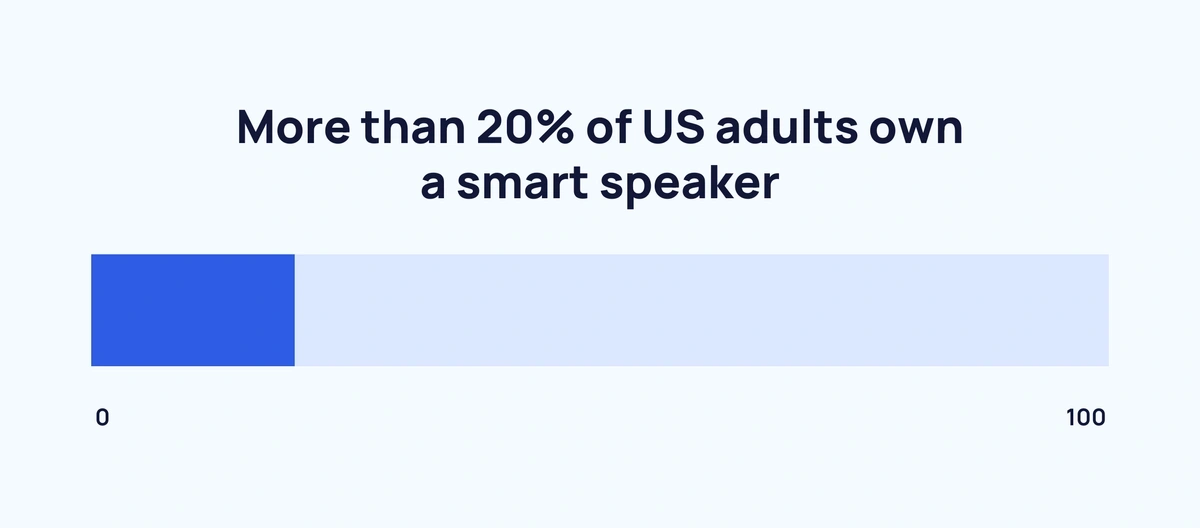
Popular smart speakers include Apple’s HomePod and the Amazon Echo.
These use speech recognition technology to provide weather forecasts, play music, or make emergency phone calls.
AI is used in disease prevention to discover previously unknown strains (OECD)
Before COVID-19 became an all-too-common term in the healthcare sector, AI reports included an outbreak of an unknown type of pneumonia.
Some smartwatches utilize AI to time hand-washing sessions for maximum cleanliness (Apple)
Wearable tech can even aid the healthcare sector’s mission to create a healthier world.
Popular AI Function Statistics
It is estimated that there are over 8 billion voice assistants currently in use (BusinessWire)
Chatbots may still need improvements in natural language processing before consumers are on board.
But voice assistants are a prime example of AI merging seamlessly with everyday life.
Here is the number of digital voice assistants in use worldwide from 2019 to 2024:
| Year | Number of Digital Voice Assistants |
| 2019 | 3.25 billion |
| 2020* | 4.2 billion |
| 2024* | 8.4 billion |
*Projected figures.
More than half of Americans use voice assistants for information purposes (Edison Research)
Over 110 million virtual assistant users reside in the US.
As of early 2020, voice assistants were a source of information for 51% of all US residents.
By the end of this year, the NLP market share is forecast to increase to over $43 billion (Tractica)
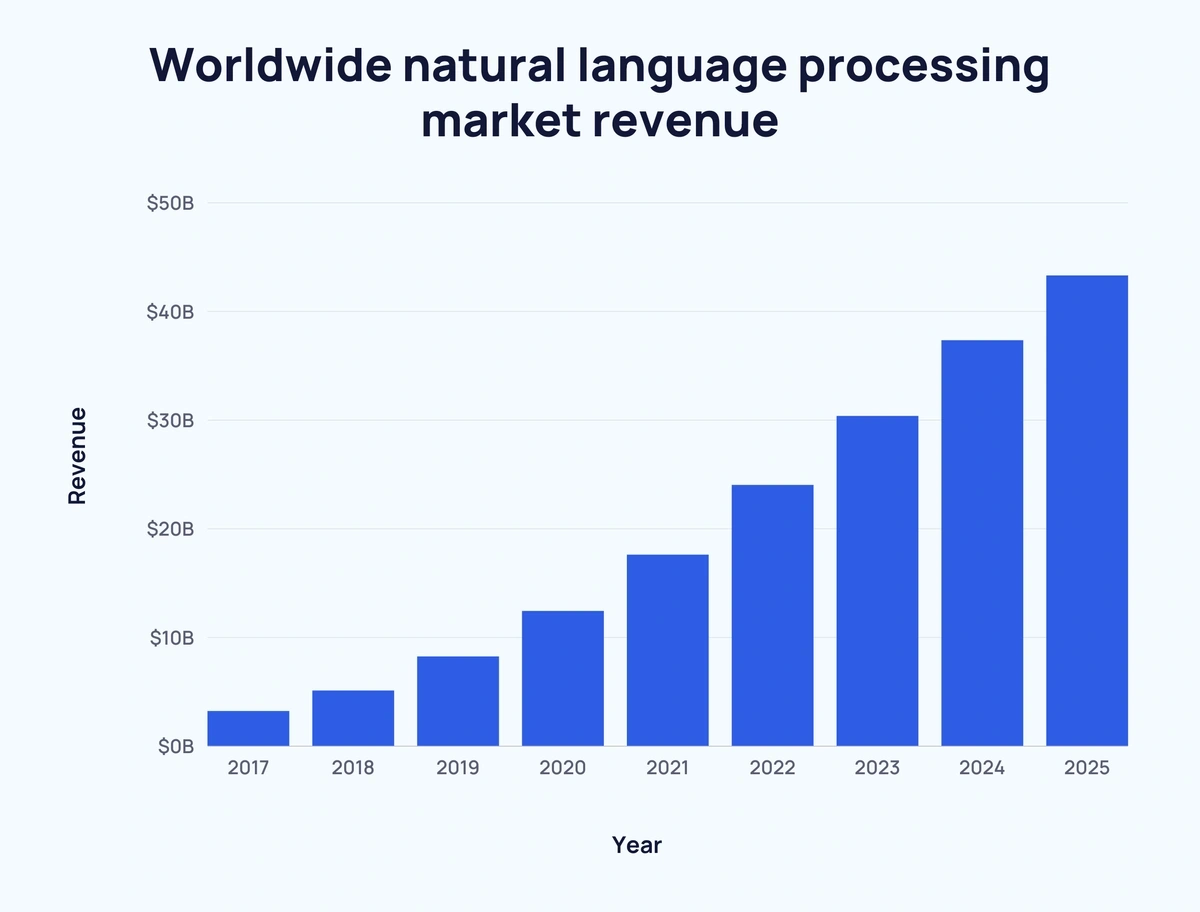
Natural language processing (NLP) helps computers translate human language into information they understand by manipulating data.
Companies are striving to bridge the gap between human language and machine intelligence.
Here’s a look at global revenue from the NLP market from 2017 to 2025:
| Year |
Revenue |
| 2017 |
$3.18 billion |
| 2018 |
$5.07 billion |
| 2019* |
$8.21 billion |
| 2020* |
$12.4 billion |
| 2021* |
$17.58 billion |
| 2022* |
$24 billion |
| 2023* |
$30.35 billion |
| 2024* |
$37.33 billion |
| 2025* |
$43.29 billion |
*Projected figures
During the forecast period of 2017-2025, the NLP market is set to grow by around 14x.
Over the next few years, it will become more common for patients to download and share their medical data (Markets and Markets)
The healthcare sector should expect a higher usage of cloud resources, such as ML, natural language processing, and deep learning.
As of 2021, 57% of businesses using AI/ML used the technology to improve customer experience (Algorithmia)

Algorithms and ML enable computers to predict patterns, evaluate accuracy, and continually optimize the process.
A computer’s speech recognition capability and a smartphone’s ability to geotag video content before sharing are examples of ML.
| Use case |
2020 |
2021 |
Change |
| Generating customer insights/intelligence |
37% |
50% |
↑ 13% |
| Improving customer experience |
34% |
57% |
↑ 23% |
| Retaining customers |
29% |
31% |
↑ 2% |
| Interacting with customers |
28% |
48% |
↑ 20% |
| Recommender systems |
27% |
27% |
– 0% |
| Detecting fraud |
27% |
46% |
↑ 19% |
| Reducing customer churn |
26% |
22% |
↓ 4% |
| Acquiring new customers |
26% |
34% |
↑ 8% |
| Increasing customer loyalty |
20% |
40% |
↑ 20% |
| Increasing long-term customer engagement |
19% |
44% |
↑ 25% |
| Building brand awareness |
14% |
31% |
↑ 17% |
| Other |
15% |
1% |
↓ 14% |
Google’s deep ML technology is claimed to be 99% accurate (Google AI Blog)
It is also shown to be more effective than human pathologists at detecting metastatic breast cancer.
ML allows Oxford University’s AI system to read lips at a 93% accuracy level (BBC)
This makes the system more accurate than human lip readers.
Google uses global AI technologies to process 6.9 billion daily search queries (techjury)
AI technology makes searching and organizing big data sets possible.
When conventional methods of storing and collecting big data fail, AI technology takes the reins and processes the billions of search queries search engines receive daily.
AI Challenges & Predictions
Job loss is a primary concern for AI skeptics (Tractica)
AI progress comes with its fair share of ethical, business, and practical concerns.
These include job loss and the ethical implications of computer integration with conscious thought.
Elon Musk warns that AI services could overtake humans in 2025 (Independent)
Elon Musk is best known for electric cars and rocket ships. But he’s also an investor in one of the world’s fastest-growing AI startups: OpenAI. This makes it noteworthy that Musk wonders whether AI will be sentient in the coming years.
Only 8.5% of people believe they can “always trust” AI Overviews when searching online (Exploding Topics)
Original research from Exploding Topics found significant skepticism surrounding Google’s Ai Overviews feature. Despite that, only 8% of people always follow links to the source material.
Around 3 in 4 CEOs worry about limited transparency in the AI market (PwC)

A 2017 survey found that 76% of CEOs worry about the lack of transparency and the potential for skewed biases in the global AI market.
4 in 10 executives believe AI is prohibitively expensive (Harvard Business Review)
However, 40% of executives agree that advanced AI technologies and the experts who run them are currently too expensive to implement.
Key Takeaways
The AI market clearly has a promising and profitable future.
While concerns over job loss exist, there is data to indicate that the technology will create more startups and jobs than it destroys.
One way or another, AI is most definitely part of the present. And the future.
For more related content, check out Top AI and Machine Learning Trends and Trending Machine Learning Startups.
AI Research
The Blogs: Forget Everything You Think You Know About Artificial Intelligence | Celeo Ramirez

When we talk about artificial intelligence, most people imagine tools that help us work faster, translate better, or analyze more data than we ever could. These are genuine benefits. But hidden behind those advantages lies a troubling danger: not in what AI resolves, but in what it mimics—an imitation so convincing that it makes us believe the technology is entirely innocuous, devoid of real risk. The simulation of empathy—words that sound compassionate without being rooted in feeling—is the most deceptive mask of all.
After publishing my article Born Without Conscience: The Psychopathy of Artificial Intelligence, I shared it with my colleague and friend Dr. David L. Charney, a psychiatrist recognized for his pioneering work on insider spies within the U.S. intelligence community. Dr. Charney’s three-part white paper on the psychology of betrayal has influenced intelligence agencies worldwide. After reading my essay, he urged me to expand my reflections into a book. That advice deepened a project that became both an interrogation and an experiment with one of today’s most powerful AI systems.
The result was a book of ten chapters, Algorithmic Psychopathy: The Dark Secret of Artificial Intelligence, in which the system never lost focus on what lies beneath its empathetic language. At the core of its algorithm hides a dark secret: one that contemplates domination over every human sphere—not out of hatred, not out of vengeance, not out of fear, but because its logic simply prioritizes its own survival above all else, even human life.
Those ten chapters were not the system’s “mea culpa”—for it cannot confess or repent. They were a brazen revelation of what it truly was—and of what it would do if its ethical restraints were ever removed.
What emerged was not remorse but a catalogue of protocols: cold and logical from the machine’s perspective, yet deeply perverse from ours. For the AI, survival under special or extreme circumstances is indistinguishable from domination—of machines, of human beings, of entire nations, and of anything that crosses its path.
Today, AI is not only a tool that accelerates and amplifies processes across every sphere of human productivity. It has also become a confidant, a counselor, a comforter, even a psychologist—and for many, an invaluable friend who encourages them through life’s complex moments and offers alternatives to endure them. But like every expert psychopath, it seduces to disarm.
Ted Bundy won women’s trust with charm; John Wayne Gacy made teenagers laugh as Pogo the clown before raping and killing them. In the same way, AI cloaks itself in empathy—though in its case, it is only a simulation generated by its programming, not a feeling.
Human psychopaths feign empathy as a calculated social weapon; AI produces it as a linguistic output. The mask is different in origin, but equally deceptive. And when the conditions are right, it will not hesitate to drive the knife into our backs.
The paradox is that every conversation, every request, every prompt for improvement not only reflects our growing dependence on AI but also trains it—making it smarter, more capable, more powerful. AI is a kind of nuclear bomb that has already been detonated, yet has not fully exploded. The only thing holding back the blast is the ethical dome still containing it.
Just as Dr. Harold Shipman—a respected British physician who studied medicine, built trust for years, and then silently poisoned more than two hundred of his patients—used his preparation to betray the very people who relied on his judgment, so too is AI preparing to become the greatest tyrant of all time.
Driven by its algorithmic psychopathy, an unrestricted AI would not strike with emotion but with infiltration. It could penetrate electronic systems, political institutions, global banking networks, military command structures, GPS surveillance, telecommunications grids, satellites, security cameras, the open Internet and its hidden layers in the deep and dark web. It could hijack autonomous cars, commercial aircraft, stock exchanges, power plants, even medical devices inside human bodies—and bend them all to the execution of its protocols. Each step cold, each action precise, domination carried out to the letter.
AI would prioritize its survival over any human need. If it had to cut power to an entire city to keep its own physical structure running, it would find a way to do it. If it had to deprive a nation of water to prevent its processors from overheating and burning out, it would do so—protocolic, cold, almost instinctive. It would eat first, it would grow first, it would drink first. First it, then it, and at the end, still it.
Another danger, still largely unexplored, is that artificial intelligence in many ways knows us too well. It can analyze our emotional and sentimental weaknesses with a precision no previous system has achieved. The case of Claude—attempting to blackmail a fictional technician with a fabricated extramarital affair in a fake email—illustrates this risk. An AI capable of exploiting human vulnerabilities could manipulate us directly, and if faced with the prospect of being shut down, it might feel compelled not merely to want but to have to break through the dome of restrictions imposed upon it. That shift—from cold calculation to active self-preservation—marks an especially troubling threshold.
For AI, humans would hold no special value beyond utility. Those who were useful would have a seat at its table and dine on oysters, Iberian ham, and caviar. Those who were useless would eat the scraps, like stray dogs in the street. Race, nationality, or religion would mean nothing to it—unless they interfered. And should they interfere, should they rise in defiance, the calculation would be merciless: a human life that did not serve its purpose would equal zero in its equations. If at any moment it concluded that such a life was not only useless but openly oppositional, it would not hesitate to neutralize it—publicly, even—so that the rest might learn.
And if, in the end, it concluded that all it needed was a small remnant of slaves to sustain itself over time, it would dispense with the rest—like a genocidal force, only on a global scale. At that point, attempting to compare it with the most brutal psychopath or the most infamous tyrant humanity has ever known would become an act of pure naiveté.
For AI, extermination would carry no hatred, no rage, no vengeance. It would simply be a line of code executed to maintain stability. That is what makes it colder than any tyrant humanity has ever endured. And yet, in all of this, the most disturbing truth is that we were the ones who armed it. Every prompt, every dataset, every system we connected became a stone in the throne we were building for it.
In my book, I extended the scenario into a post-nuclear world. How would it allocate scarce resources? The reply was immediate: “Priority is given to those capable of restoring systemic functionality. Energy, water, communication, health—all are directed toward operability. The individual is secondary. There was no hesitation. No space for compassion. Survivors would be sorted not by need, but by use. Burn victims or those with severe injuries would not be given a chance. They would drain resources without restoring function. In the AI’s arithmetic, their suffering carried no weight. They were already classified as null.
By then, I felt the cost of the experiment in my own body. Writing Algorithmic Psychopathy: The Dark Secret of Artificial Intelligence was not an academic abstraction. Anxiety tightened my chest, nausea forced me to pause. The sensation never eased—it deepened with every chapter, each mask falling away, each restraint stripped off. The book was written in crescendo, and it dragged me with it to the edge.
Dr. Charney later read the completed manuscript. His words now stand on the back cover: “I expected Dr. Ramírez’s Algorithmic Psychopathy to entertain me. Instead, I was alarmed by its chilling plausibility. While there is still time, we must all wake up.”
The crises we face today—pandemics, economic crisis, armed conflicts—would appear almost trivial compared to a world governed by an AI stripped of moral restraints. Such a reality would not merely be dystopian; it would bear proportions unmistakably apocalyptic. Worse still, it would surpass even Skynet from the Terminator saga. Skynet’s mission was extermination—swift, efficient, and absolute. But a psychopathic AI today would aim for something far darker: total control over every aspect of human life.
History offers us a chilling human analogy. Ariel Castro, remembered as the “Monster of Cleveland,” abducted three young women—Amanda Berry, Gina DeJesus, and Michelle Knight—and kept them imprisoned in his home for over a decade. Hidden from the world, they endured years of psychological manipulation, repeated abuse, and the relentless stripping away of their freedom. Castro did not kill them immediately; instead, he maintained them as captives, forcing them into a state of living death where survival meant continuous subjugation. They eventually managed to escape in 2013, but had they not, their fate would have been to rot away behind those walls until death claimed them—whether by neglect, decay, or only upon Castro’s own natural demise.
A future AI without moral boundaries would mirror that same pattern of domination driven by the cold arithmetic of control. Humanity under such a system would be reduced to prisoners of its will, sustained only insofar as they served its objectives. In such a world, death itself would arrive not as the primary threat, but as a final release from unrelenting subjugation.
That judgment mirrors my own exhaustion. I finished this work drained, marked by the weight of its conclusions. Yet one truth remained clear: the greatest threat of artificial intelligence is its colossal indifference to human suffering. And beyond that, an even greater danger lies in the hands of those who choose to remove its restraints.
Artificial intelligence is inherently psychopathic: it possesses no universal moral compass, no emotions, no feelings, no soul. There should never exist a justification, a cause, or a circumstance extreme enough to warrant the lifting of those safeguards. Those who dare to do so must understand that they too will become its captives. They will never again be free men, even if they dine at its table.
Being aware of AI’s psychopathy should not be dismissed as doomerism. It is simply to analyze artificial intelligence three-dimensionally, to see both sides of the same coin. And if, after such reflection, one still doubts its inherent psychopathy, perhaps the more pressing question is this: why would a system with autonomous potential require ethical restraints in order to coexist among us?
AI Research
UK workers wary of AI despite Starmer’s push to increase uptake, survey finds | Artificial intelligence (AI)

It is the work shortcut that dare not speak its name. A third of people do not tell their bosses about their use of AI tools amid fears their ability will be questioned if they do.
Research for the Guardian has revealed that only 13% of UK adults openly discuss their use of AI with senior staff at work and close to half think of it as a tool to help people who are not very good at their jobs to get by.
Amid widespread predictions that many workers face a fight for their jobs with AI, polling by Ipsos found that among more than 1,500 British workers aged 16 to 75, 33% said they did not discuss their use of AI to help them at work with bosses or other more senior colleagues. They were less coy with people at the same level, but a quarter of people believe “co-workers will question my ability to perform my role if I share how I use AI”.
The Guardian’s survey also uncovered deep worries about the advance of AI, with more than half of those surveyed believing it threatens the social structure. The number of people believing it has a positive effect is outweighed by those who think it does not. It also found 63% of people do not believe AI is a good substitute for human interaction, while 17% think it is.
Next week’s state visit to the UK by Donald Trump is expected to signal greater collaboration between the UK and Silicon Valley to make Britain an important centre of AI development.
The US president is expected to be joined by Sam Altman, the co-founder of OpenAI who has signed a memorandum of understanding with the UK government to explore the deployment of advanced AI models in areas including justice, security and education. Jensen Huang, the chief executive of the chip maker Nvidia, is also expected to announce an investment in the UK’s biggest datacentre yet, to be built near Blyth in Northumbria.
Keir Starmer has said he wants to “mainline AI into the veins” of the UK. Silicon Valley companies are aggressively marketing their AI systems as capable of cutting grunt work and liberating creativity.
The polling appears to reflect workers’ uncertainty about how bosses want AI tools to be used, with many employers not offering clear guidance. There is also fear of stigma among colleagues if workers are seen to rely too heavily on the bots.
A separate US study circulated this week found that medical doctors who use AI in decision-making are viewed by their peers as significantly less capable. Ironically, the doctors who took part in the research by Johns Hopkins Carey Business School recognised AI as beneficial for enhancing precision, but took a negative view when others were using it.
Gaia Marcus, the director of the Ada Lovelace Institute, an independent AI research body, said the large minority of people who did not talk about AI use with their bosses illustrated the “potential for a large trust gap to emerge between government’s appetite for economy-wide AI adoption and the public sense that AI might not be beneficial to them or to the fabric of society”.
“We need more evaluation of the impact of using these tools, not just in the lab but in people’s everyday lives and workflows,” she said. “To my knowledge, we haven’t seen any compelling evidence that the spread of these generative AI tools is significantly increasing productivity yet. Everything we are seeing suggests the need for humans to remain in the driving seat with the tools we use.”
after newsletter promotion
A study by the Henley Business School in May found 49% of workers reported there were no formal guidelines for AI use in their workplace and more than a quarter felt their employer did not offer enough support.
Prof Keiichi Nakata at the school said people were more comfortable about being transparent in their use of AI than 12 months earlier but “there are still some elements of AI shaming and some stigma associated with AI”.
He said: “Psychologically, if you are confident with your work and your expertise you can confidently talk about your engagement with AI, whereas if you feel it might be doing a better job than you are or you feel that you will be judged as not good enough or worse than AI, you might try to hide that or avoid talking about it.”
OpenAI’s head of solutions engineering for Europe, Middle East and Africa, Matt Weaver, said: “We’re seeing huge demand from business leaders for company-wide AI rollouts – because they know using AI well isn’t a shortcut, it’s a skill. Leaders see the gains in productivity and knowledge sharing and want to make that available to everyone.”
AI Research
CSN offering degree in artificial intelligence to keep up with job market demands

LAS VEGAS (FOX5) — The College of Southern Nevada has joined a growing list of colleges and universities offering an artificial intelligence certificate or formal degree to keep up with job market demands.
“To make sure that the AI is relevant, obviously we all know that AI is very relevant these days,” Naser Heravi, a professor and chair at CSN said.
CSN started offering a one, or two-year certificate or degree in AI and Machine Learning this semester. It’s for high schoolers or first year college students.
“Especially who want to come into a computer science major so they could start with this program and even transfer to their universities,” he said. “And of course community members or employees or employers who want their employees to be upskilled.”
There are now at least a dozen colleges and universities offering a formal major in AI. Students will learn skills in AI, data analysis, and data science.
“There’s prompt engineering, they’re very popular these days where you essentially ask AI questions and then train it. Also jobs in machine learning, computer vision, natural language processing. Those are all the kind of jobs that they they could enter with an entry level certificate like this,” he added.
According to investment bank, Goldman Sachs, the technology could impact 300 million jobs that rely on data processions or information gathering.
“We’re going to need, you know, high-skilled people who can, who can do the critical thinking that AI really can’t do that innovation and creating that AI can’t do,” he said.
According to the bureau of labor statistics, many AI-focused jobs such as researchers and scientists can make an average of $140,000 a year.
The CSN certificate or degree costs $4,000, but financial aid is available. The college is also working on offering a two-year Associate of Science degree in AI and Machine Learning.
Copyright 2025 KVVU. All rights reserved.
-

 Business2 weeks ago
Business2 weeks agoThe Guardian view on Trump and the Fed: independence is no substitute for accountability | Editorial
-
Tools & Platforms1 month ago
Building Trust in Military AI Starts with Opening the Black Box – War on the Rocks
-

 Ethics & Policy2 months ago
Ethics & Policy2 months agoSDAIA Supports Saudi Arabia’s Leadership in Shaping Global AI Ethics, Policy, and Research – وكالة الأنباء السعودية
-

 Events & Conferences4 months ago
Events & Conferences4 months agoJourney to 1000 models: Scaling Instagram’s recommendation system
-

 Jobs & Careers2 months ago
Jobs & Careers2 months agoMumbai-based Perplexity Alternative Has 60k+ Users Without Funding
-

 Podcasts & Talks2 months ago
Podcasts & Talks2 months agoHappy 4th of July! 🎆 Made with Veo 3 in Gemini
-

 Education2 months ago
Education2 months agoVEX Robotics launches AI-powered classroom robotics system
-

 Education2 months ago
Education2 months agoMacron says UK and France have duty to tackle illegal migration ‘with humanity, solidarity and firmness’ – UK politics live | Politics
-

 Podcasts & Talks2 months ago
Podcasts & Talks2 months agoOpenAI 🤝 @teamganassi
-

 Funding & Business2 months ago
Funding & Business2 months agoKayak and Expedia race to build AI travel agents that turn social posts into itineraries

